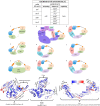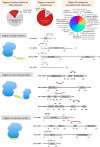Design Principles Involving Protein Disorder Facilitate Specific Substrate Selection and Degradation by the Ubiquitin-Proteasome System
- PMID: 26851277
- PMCID: PMC4807260
- DOI: 10.1074/jbc.R115.692665
Design Principles Involving Protein Disorder Facilitate Specific Substrate Selection and Degradation by the Ubiquitin-Proteasome System
Abstract
The ubiquitin-proteasome system (UPS) regulates diverse cellular pathways by the timely removal (or processing) of proteins. Here we review the role of structural disorder and conformational flexibility in the different aspects of degradation. First, we discuss post-translational modifications within disordered regions that regulate E3 ligase localization, conformation, and enzymatic activity, and also the role of flexible linkers in mediating ubiquitin transfer and reaction processivity. Next we review well studied substrates and discuss that substrate elements (degrons) recognized by E3 ligases are highly disordered: short linear motifs recognized by many E3s constitute an important class of degrons, and these are almost always present in disordered regions. Substrate lysines targeted for ubiquitination are also often located in neighboring regions of the E3 docking motifs and are therefore part of the disordered segment. Finally, biochemical experiments and predictions show that initiation of degradation at the 26S proteasome requires a partially unfolded region to facilitate substrate entry into the proteasomal core.
Keywords: E3 ligase; E3 ubiquitin ligase; intrinsically disordered protein; proteasome; protein degradation; protein phosphorylation; protein structural disorder; regulated degradation; ubiquitylation (ubiquitination).
© 2016 by The American Society for Biochemistry and Molecular Biology, Inc.
Figures


References
-
- Ciechanover A. (2012) Intracellular protein degradation: from a vague idea thru the lysosome and the ubiquitin-proteasome system and onto human diseases and drug targeting. Biochim. Biophys. Acta 1824, 3–13 - PubMed
-
- Teixeira L. K., and Reed S. I. (2013) Ubiquitin ligases and cell cycle control. Annu. Rev. Biochem. 82, 387–414 - PubMed
-
- Craney A., and Rape M. (2013) Dynamic regulation of ubiquitin-dependent cell cycle control. Curr. Opin. Cell Biol. 25, 704–710 - PubMed
-
- Bhat K. P., and Greer S. F. (2011) Proteolytic and non-proteolytic roles of ubiquitin and the ubiquitin proteasome system in transcriptional regulation. Biochim. Biophys. Acta 1809, 150–155 - PubMed
Publication types
MeSH terms
Substances
Associated data
- Actions
- Actions
- Actions
- Actions
- Actions
- Actions
LinkOut - more resources
Full Text Sources
Other Literature Sources

